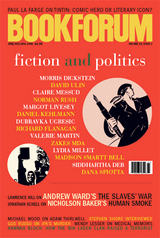
In Mac Wellman’s universe, a radish can be used as an eye, a young girl can fall in love with a toucan, and some folks still use faxes. Best known for his experimental plays, Wellman has also published four volumes of poetry and three novels—works describing self-contained worlds that question our cultural preoccupations and assumptions. His latest book continues this practice: A Chronicle of the Madness of Small Worlds is a collection of short stories—or, as the author would have it, an interconnected series of planetoids—that, while comically inventive, rings with the sound of our contemporary moment. Add the alchemical wordplay of Lewis Carroll and the satiric geometry of Edwin Abbott to Italo Calvino’s Cosmicomics, and you’ll have some idea of what Wellman has done here.
Chronicle is a daunting and subversive rumination on the relationship between how we live and the language we use when we do so. One narrator asks, “Isn’t the strangest fact about a world always something which does not exist in its language?” Indeed, Wellman, who has cited H. L. Mencken’s study The American Language as an influence, probes boundaries between the spoken and the written. He torques words into strange new arrangements that become fantastic linguistic realms in themselves: The narrator on Mitake-Mura exclaims, “I stand, scrolled up before you, glittering in my seven sapphires, runcinates of leaf chicory, Zoathra and tegumenta of Zanzibar gold hammered so thin it trembles.” These word-worlds are absurd and meditative: On Wu World Woo, every inhabitant is named Mary Carnivorous Rabbit, and the narrator on Muazzez asks, “Do all my dreams take place while I am asleep?” Reading these stories at times resembles its own kind of madness. The planet Linda Susan dissolves into a collection of symbols, words, and numbers, the first fragment of which reads simply: “. . . X{Y}.” If the text itself is frequently elusive, such moments are meant to evoke estrangement. Wee Elmer, after all, “is the kind of place where folks go when they’ve given up all hope of finding a meaning to the empty riddle of their old lives.”
One planet, shaped like a Klein bottle, is mirrored in a romantic relationship on another, Sawyer Hogg: “Our embraces involved us in postures so extreme they caused one to doubt the natural order . . . unable to sort out which was whose and how we interracted.” The Klein bottle is a three-dimensional object formed as a closed surface with only one side (a bit like the two-dimensional Möbius strip), and in Chronicle, it implies the possibility of a limitless existence. An author’s note states that “all of the worlds described herein are real. . . . The prophecy of Eulalia [the Greek name meaning ‘to speak well’], referred to throughout this volume, is simply the notion that all these strange, miniature worlds were originally part of one, larger, and presumably happier place.” Wellman’s unique ability to make viable the impossible proposes, perhaps, that one larger, happier place may still somehow be possible.
